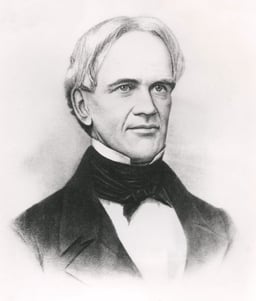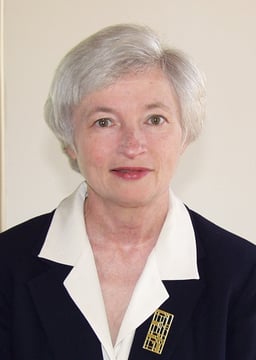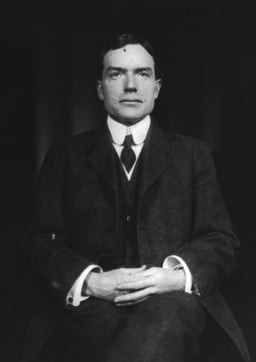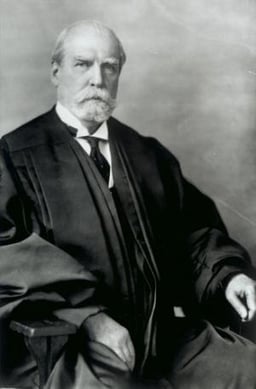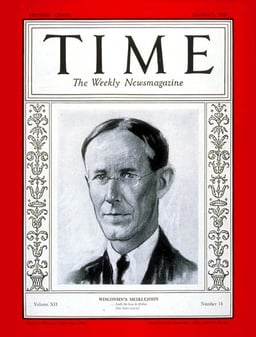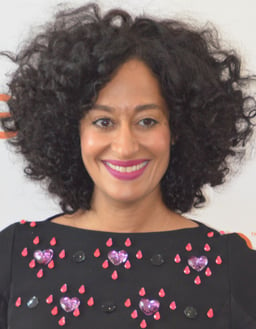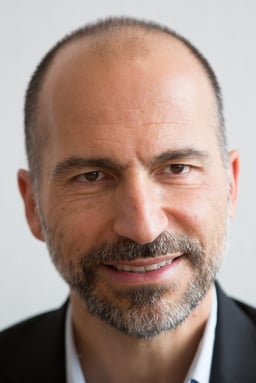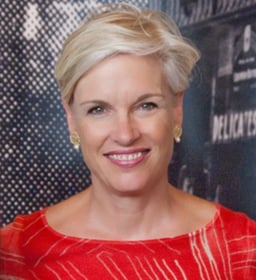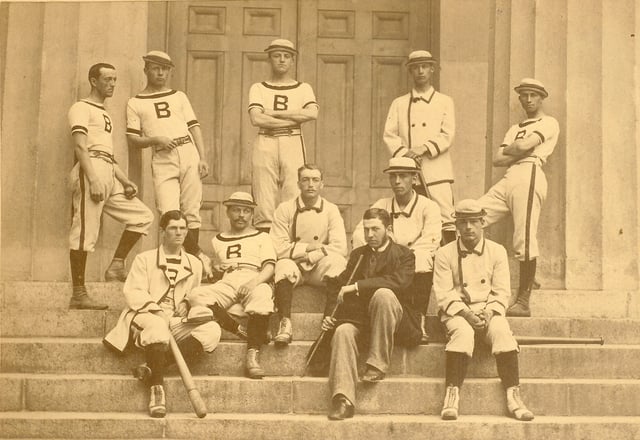Brown University

Brown University

| Latin: Universitas Brunensis | |
Former names | Rhode Island College (1764–1804) |
|---|---|
| Motto | In Deo Speramus (Latin) |
Motto in English | In God We Hope[2] |
| Type | Private |
| Established | September 15, 1764 (1764-09-15) |
Academic affiliations |
|
| Endowment | US$3.8 billion[3] (2018) |
| President | Christina Paxson |
| Provost | Richard M. Locke[4] |
Academic staff | 758 (2017–18)[5] |
| Students | 10,257 (Fall 2018)[6] |
| Undergraduates | 7,043 (Fall 2018)[7] |
| Postgraduates | 2,629 (Fall 2018)[7] |
Other students | 585 (medical)[7] |
| Location | Providence ,,United States 41°49′34″N 71°24′12″W [159] |
| Campus | Urban 143 acres (579,000 m²) |
| Colors | Brown, White, and Cardinal[8] |
| Nickname | Bears |
Sporting affiliations | NCAA Division I – Ivy League ECAC Hockey, EARC/EAWRC |
| Mascot | Bruno the Bear |
| Website | brown.edu [160] |
| University rankings | |
| National | |
| ARWU[131] | 38 |
| Forbes[132] | 7 |
| Times/WSJ[133] | 7 |
| U.S. News & World Report[134] | 14 |
| Washington Monthly[135] | 28 |
| Global | |
| ARWU[136] | 84 |
| QS[137] | 57 |
| Times[138] | 53 |
| U.S. News & World Report[139] | 99 |
USNWR graduate school rankings [140] | |
| Engineering | 47 |
| Medicine: Primary Care | 26 |
| Medicine: Research | 36 |
USNWR departmental rankings [140] | |
| Applied Mathematics | 4 |
| Biological Sciences | 33 |
| Chemistry | 59 |
| Computer Science | 25 |
| Earth Sciences | 15 |
| Economics | 19 |
| English | 13 |
| History | 16 |
| Mathematics | 14 |
| Physics | 35 |
| Political Science | 40 |
| Psychology | 26 |
| Public Affairs | 53 |
| Public Health | 17 |
| Sociology | 24 |
| Statistics | 44 |
Brown University is a private Ivy League research university in Providence, Rhode Island. Founded in 1764 as the College in the English Colony of Rhode Island and Providence Plantations, it is the seventh-oldest institution of higher education in the United States and one of the nine colonial colleges chartered before the American Revolution.[9]
At its foundation, Brown was the first college in the U.S. to accept students regardless of their religious affiliation.[10] Its engineering program was established in 1847. It was one of the early doctoral-granting U.S. institutions in the late 19th century, adding masters and doctoral studies in 1887.[11] In 1969, Brown adopted a New Curriculum sometimes referred to as the Brown Curriculum after a period of student lobbying. The New Curriculum eliminated mandatory "general education" distribution requirements, made students "the architects of their own syllabus" and allowed them to take any course for a grade of satisfactory or unrecorded no-credit.[12] In 1971, Brown's coordinate women's institution, Pembroke College, was fully merged into the university; Pembroke Campus now includes dormitories and classrooms used by all of Brown.
Undergraduate admissions is highly selective, with an acceptance rate of 6.6 percent for the class of 2023.[13] The university comprises the College, the Graduate School, Alpert Medical School, the School of Engineering, the School of Public Health and the School of Professional Studies (which includes the IE Brown Executive MBA program). Brown's international programs are organized through the Watson Institute for International and Public Affairs, and the university is academically affiliated with the Marine Biological Laboratory and the Rhode Island School of Design. The Brown/RISD Dual Degree Program, offered in conjunction with the Rhode Island School of Design, is a five-year course that awards degrees from both institutions.
Brown's main campus is located in the College Hill Historic District in the city of Providence, Rhode Island. The University's neighborhood is a federally listed architectural district with a dense concentration of Colonial-era buildings. Benefit Street, on the western edge of the campus, contains "one of the finest cohesive collections of restored seventeenth- and eighteenth-century architecture in the United States".[14]
As of August 2018, 8 Nobel Prize winners have been affiliated with Brown University as alumni, faculty members or researchers. In addition, Brown's faculty and alumni include 5 National Humanities Medalists[15] and 10 National Medal of Science laureates. Other notable alumni include 8 billionaire graduates,[16] a U.S. Supreme Court Chief Justice, 4 U.S. Secretaries of State and other Cabinet officials, 54 members of the United States Congress, 56 Rhodes Scholars, 52 Gates Cambridge Scholars[17] 49 Marshall Scholars,[18][19] 14 MacArthur Genius Fellows,[20] 23 Pulitzer Prize winners, various royals and nobles, as well as leaders and founders of Fortune 500 companies.[21]
| Latin: Universitas Brunensis | |
Former names | Rhode Island College (1764–1804) |
|---|---|
| Motto | In Deo Speramus (Latin) |
Motto in English | In God We Hope[2] |
| Type | Private |
| Established | September 15, 1764 (1764-09-15) |
Academic affiliations |
|
| Endowment | US$3.8 billion[3] (2018) |
| President | Christina Paxson |
| Provost | Richard M. Locke[4] |
Academic staff | 758 (2017–18)[5] |
| Students | 10,257 (Fall 2018)[6] |
| Undergraduates | 7,043 (Fall 2018)[7] |
| Postgraduates | 2,629 (Fall 2018)[7] |
Other students | 585 (medical)[7] |
| Location | Providence ,,United States 41°49′34″N 71°24′12″W [159] |
| Campus | Urban 143 acres (579,000 m²) |
| Colors | Brown, White, and Cardinal[8] |
| Nickname | Bears |
Sporting affiliations | NCAA Division I – Ivy League ECAC Hockey, EARC/EAWRC |
| Mascot | Bruno the Bear |
| Website | brown.edu [160] |
| University rankings | |
| National | |
| ARWU[131] | 38 |
| Forbes[132] | 7 |
| Times/WSJ[133] | 7 |
| U.S. News & World Report[134] | 14 |
| Washington Monthly[135] | 28 |
| Global | |
| ARWU[136] | 84 |
| QS[137] | 57 |
| Times[138] | 53 |
| U.S. News & World Report[139] | 99 |
USNWR graduate school rankings [140] | |
| Engineering | 47 |
| Medicine: Primary Care | 26 |
| Medicine: Research | 36 |
USNWR departmental rankings [140] | |
| Applied Mathematics | 4 |
| Biological Sciences | 33 |
| Chemistry | 59 |
| Computer Science | 25 |
| Earth Sciences | 15 |
| Economics | 19 |
| English | 13 |
| History | 16 |
| Mathematics | 14 |
| Physics | 35 |
| Political Science | 40 |
| Psychology | 26 |
| Public Affairs | 53 |
| Public Health | 17 |
| Sociology | 24 |
| Statistics | 44 |
History
The foundation and the charter

The Ezra Stiles copy of the Brown University Charter of 1764

The first president, James Manning, taught the earliest college classes at his parish house
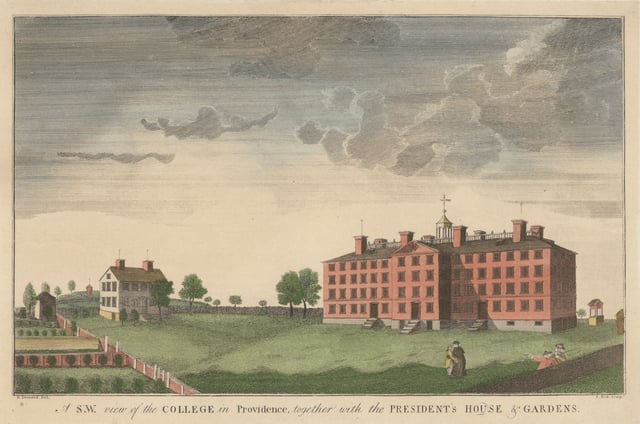
University Hall (right) and president's house, engraving 1792
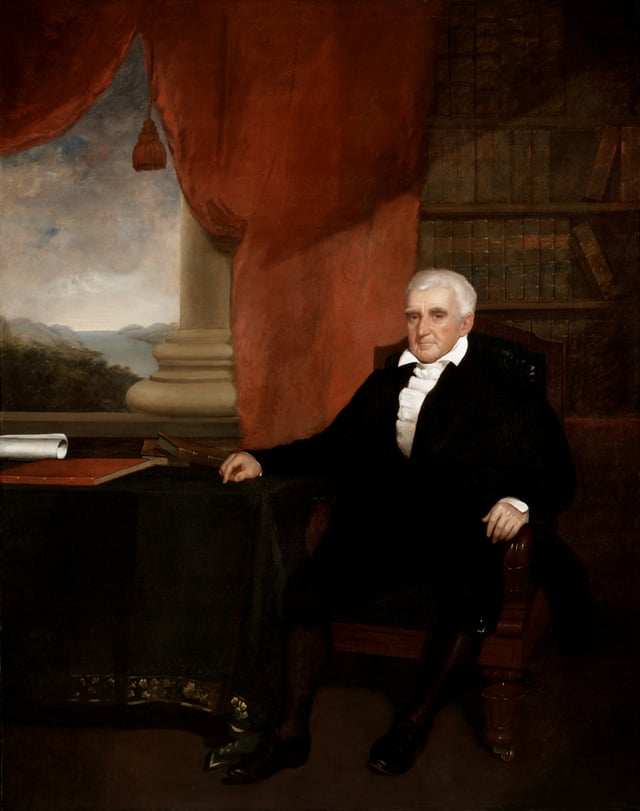
Nicholas Brown, Jr., founder of the Providence Athenaeum, co-founder of Butler Hospital, philanthropist, progressive, and abolitionist. Following his major gift in 1804, the College was renamed Brown University. Painting by Chester Harding, 1836
The origin of Brown University can be dated to 1761, when three residents of Newport, Rhode Island drafted a petition to the General Assembly of the colony:[22]
Your Petitioners propose to open a literary institution or School for instructing young Gentlemen in the Languages, Mathematics, Geography & History, & such other branches of Knowledge as shall be desired. That for this End ... it will be necessary ... to erect a public Building or Buildings for the boarding of the youth & the Residence of the Professors.
The three petitioners were Ezra Stiles, pastor of Newport's Second Congregational Church and future president of Yale; William Ellery, Jr., future signer of the United States Declaration of Independence; and Josias Lyndon, future governor of the colony. Stiles and Ellery were co-authors of the Charter of the College two years later. The editor of Stiles's papers observes, "This draft of a petition connects itself with other evidence of Dr. Stiles's project for a Collegiate Institution in Rhode Island, before the charter of what became Brown University."[23]
There is further documentary evidence that Stiles was making plans for a college in 1762. On January 20, Chauncey Whittelsey, pastor of the First Church of New Haven, answered a letter from Stiles:[24]
The week before last I sent you the Copy of Yale College Charter ... Should you make any Progress in the Affair of a Colledge, I should be glad to hear of it; I heartily wish you Success therein.
The Philadelphia Association of Baptist Churches also had an eye on Rhode Island, home of the mother church of their denomination: the First Baptist Church in America, founded in Providence in 1638 by Roger Williams. The Baptists were as yet unrepresented among colonial colleges; the Congregationalists had Harvard and Yale, the Presbyterians had the College of New Jersey (later Princeton), and the Episcopalians had the College of William and Mary and King's College (later Columbia). Isaac Backus was the historian of the New England Baptists and an inaugural Trustee of Brown, writing in 1784. He described the October 1762 resolution taken at Philadelphia:[25]
The Philadelphia Association obtained such an acquaintance with our affairs, as to bring them to an apprehension that it was practicable and expedient to erect a college in the Colony of Rhode-Island, under the chief direction of the Baptists; ... Mr. James Manning, who took his first degree in New-Jersey college in September, 1762, was esteemed a suitable leader in this important work.
Manning arrived at Newport in July 1763 and was introduced to Stiles, who agreed to write the Charter for the College. Stiles's first draft was read to the General Assembly in August 1763 and rejected by Baptist members who worried that the College Board of Fellows would under-represent the Baptists. A revised Charter written by Stiles and Ellery was adopted by the Assembly on March 3, 1764.
In September 1764, the inaugural meeting of the College Corporation was held at Newport. Governor Stephen Hopkins was chosen chancellor, former and future governor Samuel Ward was vice chancellor, John Tillinghast treasurer, and Thomas Eyres secretary. The Charter stipulated that the Board of Trustees be composed of 22 Baptists, five Quakers, five Episcopalians, and four Congregationalists. Of the 12 Fellows, eight should be Baptists—including the College president—"and the rest indifferently of any or all Denominations."[26]
The Charter was not the grant of King George III, as is sometimes supposed, but rather an Act of the colonial General Assembly. In two particulars, the Charter may be said to be a uniquely progressive document. First, other colleges had curricular strictures against opposing doctrines, while Brown's Charter asserted, "Sectarian differences of opinions, shall not make any Part of the Public and Classical Instruction." Second, according to Brown University historian Walter Bronson, "the instrument governing Brown University recognized more broadly and fundamentally than any other the principle of denominational cooperation."[27] The oft-repeated statement is inaccurate that Brown's Charter alone prohibited a religious test for College membership; other college charters were also liberal in that particular.
James Manning was sworn in as the College's first president in 1765 and served until 1791. In 1770, the College moved from Warren, Rhode Island to the crest of College Hill overlooking Providence. Solomon Drowne, a freshman in the class of 1773, wrote in his diary on March 26, 1770:[28]
This day the Committee for settling the spot for the College, met at the New-Brick School House, when it was determined it should be set on ye Hill opposite Mr. John Jenkes; up the Presbyterian Lane.
Presbyterian Lane is the present College Street. The eight-acre site had been purchased in two parcels by the Corporation for £219, mainly from Moses Brown and John Brown, the parcels having "formed a part of the original home lots of their ancestor, Chad Brown, and of George Rickard, who bought them from the Indians." University Hall was known as "The College Edifice" until 1823; it was modelled on Nassau Hall at the College of New Jersey. Its construction was managed by the firm of Nicholas Brown and Company, which spent £2,844 in the first year building the College Edifice and the adjacent President's House.[29][30]
The Brown family
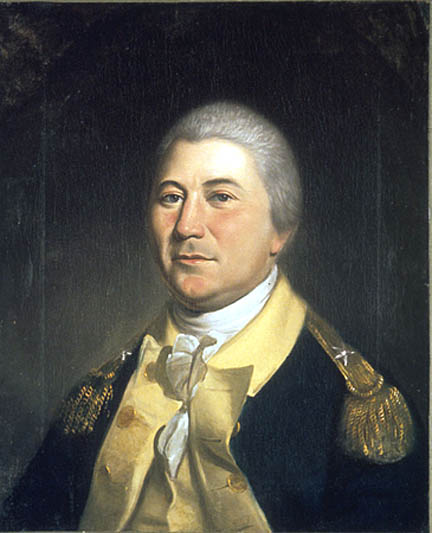
Brigadier general James Mitchell Varnum (class of 1769) served in the Continental Army and advocated the enlistment of African Americans, which resulted in the reformation of the 1st Rhode Island Regiment as an all-black unit. Painting by Charles Willson Peale, 1804
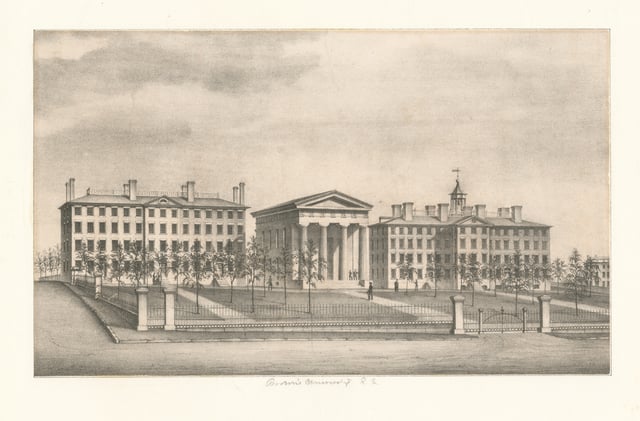
Brown University, R.I, c. 1840, New York Public Library
Nicholas Brown, his son Nicholas Brown, Jr. (class of 1786), John Brown, Joseph Brown, and Moses Brown were all instrumental in moving the College to Providence and securing its endowment. Joseph became a professor of natural philosophy at the College; John served as its treasurer from 1775 to 1796; and Nicholas Junior succeeded his uncle as treasurer from 1796 to 1825.
On September 8, 1803, the Corporation voted, "That the donation of $5000 Dollars, if made to this College within one Year from the late Commencement, shall entitle the donor to name the College." That appeal was answered by College treasurer Nicholas Brown Junior in a letter dated September 6, 1804, and the Corporation honored its promise. "In gratitude to Mr. Brown, the Corporation at the same meeting voted, 'That this College be called and known in all future time by the Name of Brown University'."[27] Over the years, the benefactions of Nicholas Brown, Jr. totaled nearly $160,000, an enormous sum for that period, and included the buildings Hope College (1821–22) and Manning Hall (1834-35).
It is sometimes erroneously supposed that Brown University was named after John Brown, whose commercial activity included the transportation of African slaves. In fact, Brown University was named for Nicholas Brown, Jr.—philanthropist, founder of the Providence Athenaeum, co-founder of Butler Hospital, and an abolitionist. Nicholas Brown, Jr. became a financier of the movement under the guidance of his uncle Moses Brown, one of the leading abolitionists of his day.[31][32]
The American Revolution
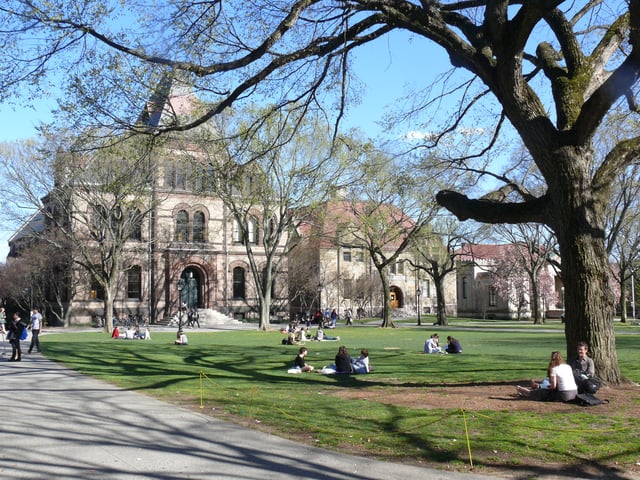
On the College Green, Sayles Hall (left), built 1878–81, designed by Alpheus C. Morse, and Wilson Hall, built 1891, designed by Gould & Angell, both buildings in the Richardsonian Romanesque style
The College library was moved out of Providence for safekeeping in the fall of 1776, with British vessels patrolling Narragansett Bay. On December 7, 1776, six thousand British and Hessian troops sailed into Newport harbor under the command of Sir Peter Parker. College President Manning said in a letter written after the war:[33]
The royal Army landed on Rhode Island & took possession of the same: This brought their Camp in plain View from the College with the naked Eye; upon which the Country flew to Arms & marched for Providence, there, unprovided with Barracks they marched into the College & dispossessed the Students, about 40 in Number.
"In the claim for damages presented by the Corporation to the United States government," says the University historian, "it is stated that the American troops used it for barracks and hospital from December 10, 1776, to April 20, 1780, and that the French troops used it for a hospital from June 26, 1780, to May 27, 1782."[34] The French troops were those of the Comte de Rochambeau.
The New Curriculum
In 1966, the first Group Independent Study Project (GISP) at Brown was formed, involving 80 students and 15 professors. The GISP was inspired by student-initiated experimental schools, especially San Francisco State College, and sought ways to "put students at the center of their education" and "teach students how to think rather than just teaching facts."[35]
Members of the GISP, Ira Magaziner and Elliot Maxwell published a paper of their findings entitled, "Draft of a Working Paper for Education at Brown University."[36][35] The paper made proposals for the new curriculum, including interdisciplinary freshman-year courses that would introduce "modes of thought," with instruction from faculty from different disciplines as well as for an end to letter grades. The following year Magaziner began organizing the student body to press for the reforms, organizing discussions and protests.[37]
In 1969, University President Ray Heffner Special Committee on Curricular Philosophy in response to student rallies held support of curriculum reform. The committee was tasked with developing specific reforms and the resulting report was called the Maeder Report after the committee's chairman. The report was presented to the faculty, which voted the New Curriculum into existence on May 7, 1969. Its key features included:[38]
Modes of Thought courses for first-year students
The introduction of interdisciplinary courses
The abandonment of "general education" distribution requirements
The Satisfactory/No Credit (S/NC) grading option
The ABC/No Credit grading system, which eliminated pluses, minuses, and D's; a grade of "No Credit" would not appear on external transcripts.
The Modes of Thought course was discontinued early on, but the other elements are still in place. In 2006, the reintroduction of plus/minus grading was broached by persons concerned about grade inflation. The idea was rejected by the College Curriculum Council after canvassing alumni, faculty, and students, including the original authors of the Magaziner-Maxwell Report.[39]
Slavery and Justice report
In 2003, then-University president Ruth Simmons launched a steering committee to study the school's eighteenth century ties to slavery with a report released four years later.[40] It prompted self-examination at other US institutions of higher learning and got the school to establish a Center for the Study of Slavery and Justice.[41]
Coat of arms

Seal of the university
Brown University's coat of arms is a white field divided into four sectors by a red cross; within each sector is an open book. Above the shield is a crest consisting of the upper half of a sun in splendor among the clouds atop a red and white torse. The sun and clouds represent "learning piercing the clouds of ignorance." The cross is believed to be a Saint George's Cross, and the open books represent learning.[42]
Campus
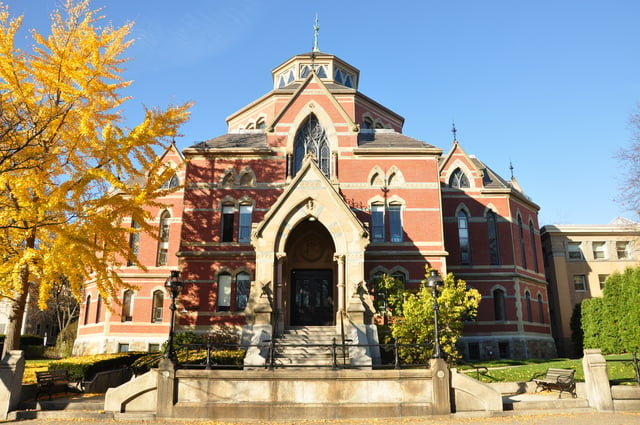
Robinson Hall, built 1875-78, designed by Walker and Gould, an octagonal building in the Venetian Gothic style. It is an example of the panoptic principle in library design inspired by the British Museum reading room[43]
Brown is the largest institutional landowner in Providence, with properties on College Hill and in the Jewelry District.[44] The College Hill campus was built contemporarily with the eighteenth- and nineteenth-century precincts that surround it, so that University buildings blend with the architectural fabric of the city. The only indicator of "campus" is a brick and wrought-iron fence on Prospect, George, and Waterman streets, enclosing the College Green and Front Green. The character of Brown's urban campus is then European organic rather than American landscaped.
Main campus
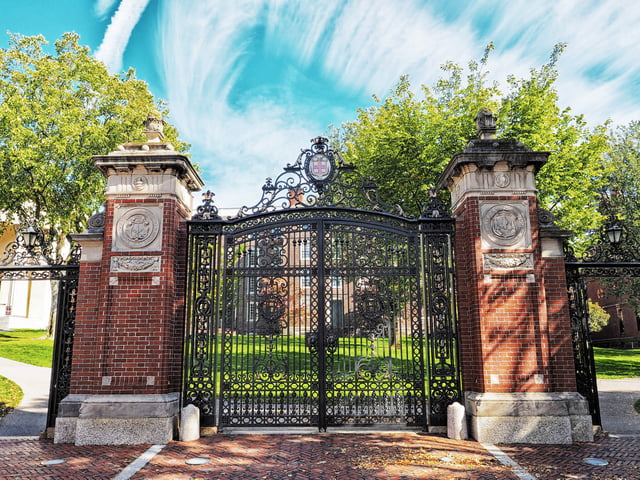
At Convocation, new students march through Van Wickle Gates, built 1900-01, designed by Hoppin and Ely of Providence and Hoppin and Koen of New York.[45] The gates were the gift of Augustus Stout Van Wickle, class of 1876, who also gave the FitzRandolph Gateway at Princeton, built 1905, as a memorial to his ancestor Nathaniel FitzRandolph

Carrie Tower, built 1904 in English Baroque style, is a memorial to Caroline Mathilde Brown, granddaughter of Nicholas Brown, class of 1786, for whom the University is named
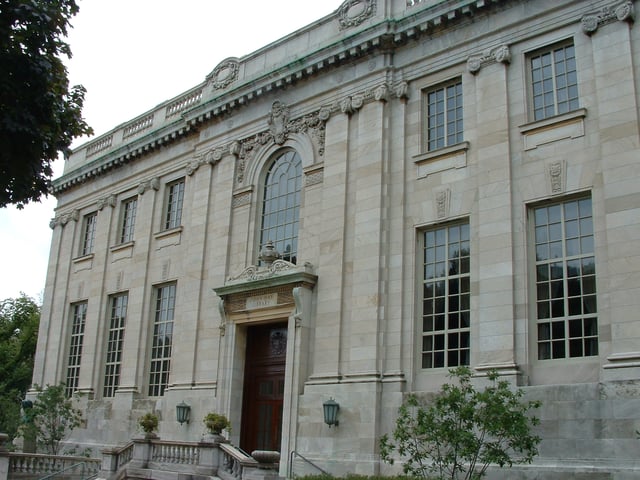
The John Hay Library, built 1910, designed by Shepley, Rutan and Coolidge in the English Renaissance style, is home to rare books, special collections, and the University archives
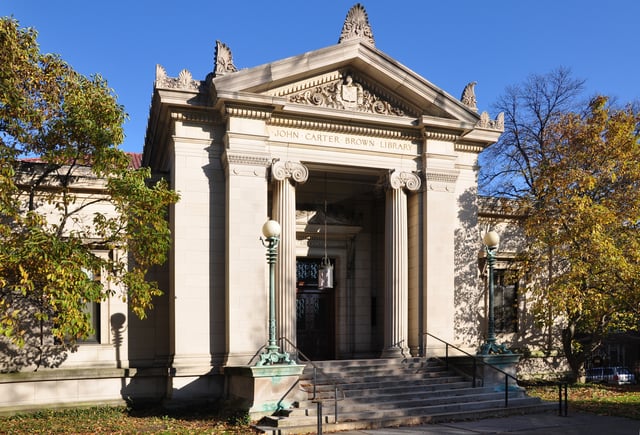
The John Carter Brown Library on the College Green, built 1898-1904, designed by Shepley, Rutan and Coolidge in the Beaux-Arts style, is one of the world's leading repositories of ancient books and maps relating to the exploration and natural history of the Americas[51]
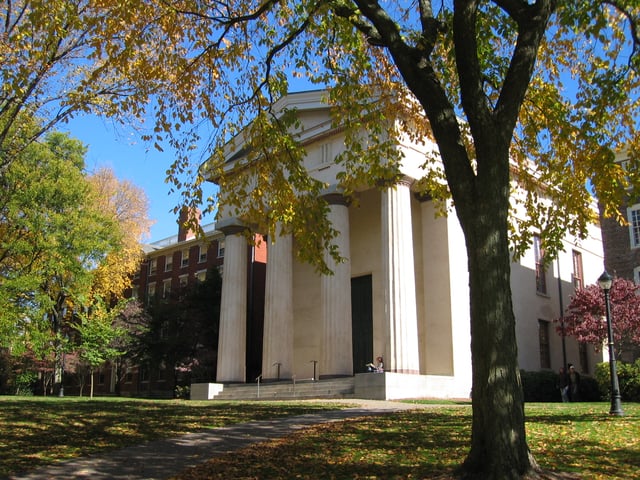
On the Front Green at the top of College Hill are Hope College (left), built 1821-22, and Manning Hall, built 1834-35, designed by Russell Warren. Both buildings were the gift of Nicholas Brown, Junior
The main campus, comprising 235 buildings and 143 acres (0.58 km2), is on College Hill in Providence's East Side. It is reached from downtown principally by three extremely steep streets—College, Waterman, and Angell—which run through the Benefit Street historic district and the campus of the Rhode Island School of Design. College Street, culminating with Van Wickle Gates at the top of the hill, is especially beautiful, and is the setting for the Convocation and Commencement processions.
Van Wickle Gates
The Van Wickle Gates, dedicated on June 18, 1901, have a pair of smaller side gates that are open year-round, and a large central gate that is opened two days a year for Convocation and Commencement. At Convocation the gate opens inward to admit the procession of new students. At Commencement the gate opens outward for the procession of graduates.[46] A Brown superstition is that students who walk through the central gate a second time prematurely will not graduate, although walking backwards is said to cancel the hex. Members of the Brown University Band famously flout the superstition by walking through the gate three times too many, as they annually play their role in the Commencement parade.
The core green spaces of the main campus are the Front (or "Quiet") Green, the College (or "Main") Green, and the Ruth J. Simmons Quadrangle (until 2012 called Lincoln Field). The old buildings on these three greens are the most photographed. The College Green includes sculptures by noted artists Henry Moore and Giuseppe Penone.[47]
Adjacent to this older campus are, to the south, academic buildings and residential quadrangles, including Wriston, Keeney, and Gregorian quadrangles; to the east, Sciences Park occupying two city blocks; to the north, connected to Simmons Quadrangle by The Walk, academic and residential precincts, including the life sciences complex and the Pembroke Campus; and to the west, on the slope of College Hill, academic buildings, including List Art Center and the Hay and Rockefeller libraries. Also on the slope of College Hill, contiguous with Brown, is the campus of the Rhode Island School of Design.
John Hay Library
The John Hay Library is the second oldest library on campus. It was opened in 1910 and named for John Hay (class of 1858, private secretary to Abraham Lincoln and Secretary of State under two Presidents) at the request of his friend Andrew Carnegie, who contributed half of the $300,000 cost of the building.[48] It is now the repository of the University's archives, rare books and manuscripts, and special collections. Noteworthy among the latter are the Anne S. K. Brown Military Collection[49] (described as "the foremost American collection of material devoted to the history and iconography of soldiers and soldiering"), the Harris Collection of American Poetry and Plays (described as "the largest and most comprehensive collection of its kind in any research library"), the Lownes Collection of the History of Science (described as "one of the three most important private collections of books of science in America"), and (for popularity of requests) the papers of H. P. Lovecraft. The Hay Library is home to one of the broadest collections of incunabula (15th-century printed books) in the Americas, as well as such rarities as the manuscript of Orwell's Nineteen Eighty-Four and a Shakespeare First Folio. There are also three books bound in human skin.[50]
John Carter Brown Library
The John Carter Brown Library, founded in 1846, is administered separately from the University, but has been located on the Main Green of the campus since 1904. It is generally regarded as the world's leading collection of primary historical sources pertaining to the Americas before 1825. It houses a very large percentage of the titles published before that date about the discovery, settlement, history, and natural history of the New World. The "JCB", as it is known, published the 29-volume Bibliotheca Americana, a principal bibliography in the field. Typical of its noteworthy holdings is the best preserved of the eleven surviving copies of the Bay Psalm Book the earliest extant book printed in British North America and the most expensive printed book in the world.[52] There is also a very fine Shakespeare First Folio, added to the collection by John Carter Brown's widow (a Shakespeare enthusiast) on the grounds that it includes The Tempest, a play set in the New World. The JCB holdings comprise more than 50,000 early titles and about 16,000 modern books, as well as prints, manuscripts, maps, and other items in the library's specialty. Manning now houses the Haffenreffer Museum of Anthropology.
Haffenreffer Museum
The exhibition galleries of the Haffenreffer Museum of Anthropology, Brown's teaching museum, are located in Manning Hall on the campus's main green. Its one million artifacts, available for research and educational purposes, are located at its Collections Research Center in Bristol, RI. The museum's goal is to inspire creative and critical thinking about culture by fostering interdisciplinary understanding of the material world. It provides opportunities for faculty and students to work with collections and the public, teaching through objects and programs in classrooms and exhibitions. The museum sponsors lectures and events in all areas of anthropology, and also runs an extensive program of outreach to local schools.
Annmary Brown Memorial

The Annmary Brown Memorial, designed by Norman Isham in 1903.
The Annmary Brown Memorial was constructed from 1903 to 1907 by politician, Civil War veteran, and book collector General Rush Hawkins, as a mausoleum for his wife, Annmary Brown, a member of the Brown family. In addition to its crypt—the final repository for Brown and Hawkins—the Memorial includes works of art from Hawkins's private collection, including paintings by Angelica Kauffman, Peter Paul Rubens, Gilbert Stuart, Giovanni Battista Tiepolo, Benjamin West, and Eastman Johnson, among others. His collection of over 450 incunabula (materials printed in Europe before 1501) was relocated to the John Hay Library in 1990.[53] Today the Memorial is home to Brown's Medieval Studies and Renaissance Studies programs.
The Walk
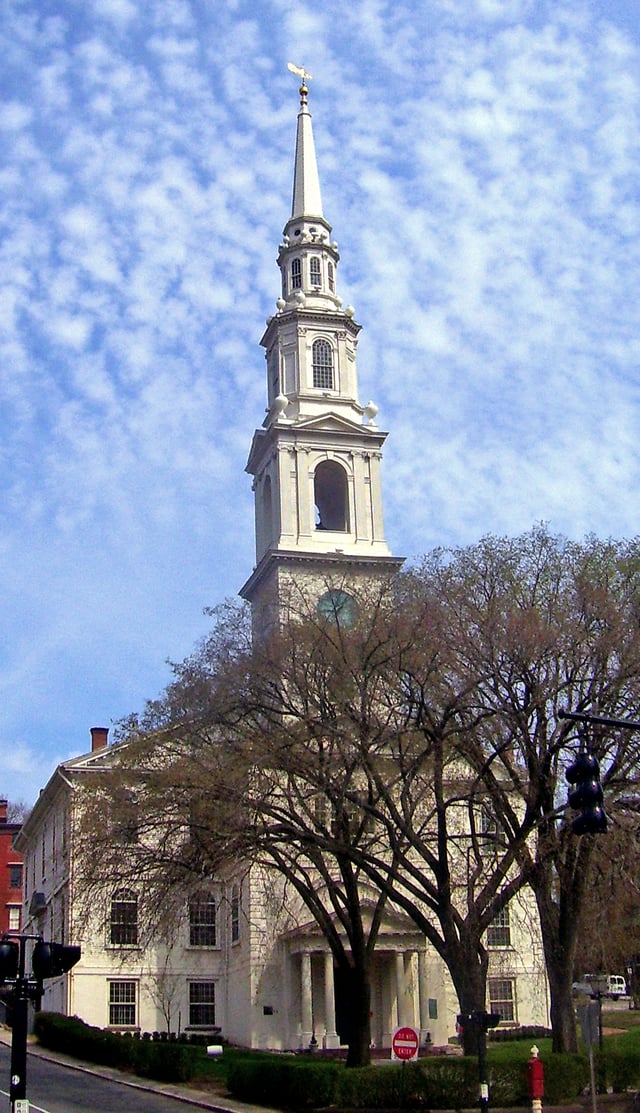
Brown Commencements have been held since 1776 in the First Baptist Church in America, built 1774-75, designed by Joseph Brown. This "meeting house" was built to accommodate 1,400 people and for the dual purpose of "the publick worship of Almighty God and also for holding commencement in"[54]
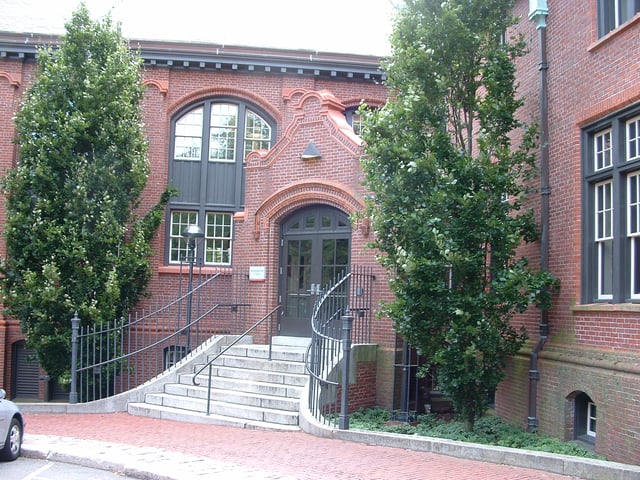
Smith-Buonanno Hall on the Pembroke Campus

Miller Hall on the Pembroke Campus
The "Walk" connects Pembroke Campus to the main campus. It is a succession of green spaces extending from Ruth Simmons Quadrangle (Lincoln Field) in the south to the Pembroke College monument on Meeting Street in the north. It is bordered by departmental buildings and the Granoff Center for the Creative Arts. A focal point of The Walk is Maya Lin's water-circulating topographical sculpture of Narragansett Bay, entitled "Under the Laurentide." Installed in 2015, it is next to the Institute for the Study of Environment and Society.[47]
Pembroke campus
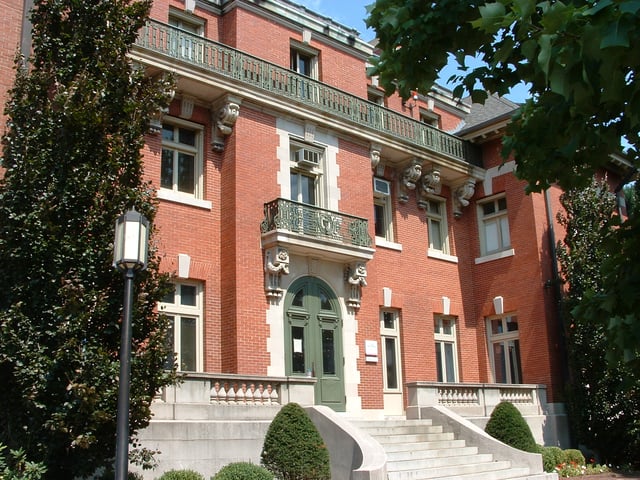
The Orwig Music Library in the former Isaac Gifford Ladd house, built 1850, acquired in 1969 when Brown bought the buildings and grounds of Bryant University on the southeast edge of the Brown campus
The Women's College in Brown University, known as Pembroke College, was founded in October 1891. When it merged with Brown in 1971, the Pembroke Campus was absorbed into the Brown campus. The Pembroke campus is centered on a quadrangle that fronts on Meeting Street, where a garden and monument—with scale-model of the quadrangle in bronze—compose the formal entry to the campus. The Pembroke campus is among the most pleasing spaces at Brown, with noteworthy examples of Victorian and Georgian architecture. The west side of the quadrangle comprises Pembroke Hall (1897), Smith-Buonanno Hall (1907, formerly Pembroke Gymnasium), and Metcalf Hall (1919); the east side comprises Alumnae Hall (1927) and Miller Hall (1910); the quadrangle culminates on the north with Andrews Hall (1947) and its terrace and garden. Pembroke Hall, originally a classroom building and library, now houses the Cogut Center for the Humanities.
East Campus, centered on Hope and Charlesfield streets, was originally the site of Bryant University. In 1969, as Bryant was preparing to move to Smithfield, Rhode Island, Brown bought their Providence campus for $5 million. This expanded the Brown campus by 10 acres (40,000 m2) and 26 buildings, included several historic houses, notably the Isaac Gifford Ladd house, built 1850 (now Brown's Orwig Music Library), and the Robert Taft House, built 1895 (now King House). The area was named East Campus in 1971.
Thayer Street runs through Brown's main campus, north to south, and is College Hill's reduced-scale counterpart to Harvard Square or Berkeley's Telegraph Avenue. Restaurants, cafes, bistros, tavernas, pubs, bookstores, second-hand shops, and the like abound. Tourists, people-watchers, buskers, and students from Providence's six colleges make the scene. Half a mile south of campus is Thayer Street's hipper cousin, Wickenden Street. More picturesque and with older architecture, it features galleries, pubs, specialty shops, artist-supply stores, and a regionally famous coffee shop that doubles as a film set (for Woody Allen and others).
Brown Stadium, built in 1925 and home to the football team, is located approximately a mile to the northeast of the main campus. Marston Boathouse, the home of the crew teams, lies on the Blackstone/Seekonk River, to the southeast of campus. Brown's Warren Alpert Medical School is situated in the historic Jewelry District of Providence, near the medical campus of Brown's teaching hospitals, Rhode Island Hospital, Women and Infants Hospital, and Hasbro Children's Hospital. Other University research facilities in the Jewelry District include the Laboratories for Molecular Medicine.
Brown's School of Public Health occupies a landmark modernist building overlooking Memorial Park on the Providence Riverwalk. Brown also owns 376-acre (1.52 km2) the Mount Hope Grant in Bristol, Rhode Island, an important Native American and King Philip's War site. Brown's Haffenreffer Museum of Anthropology Collection Research Center, particularly strong in Native American items, is located in the Mount Hope Grant.
Academics
Presidents

19th Brown president Christina Hull Paxson, 2012 to present
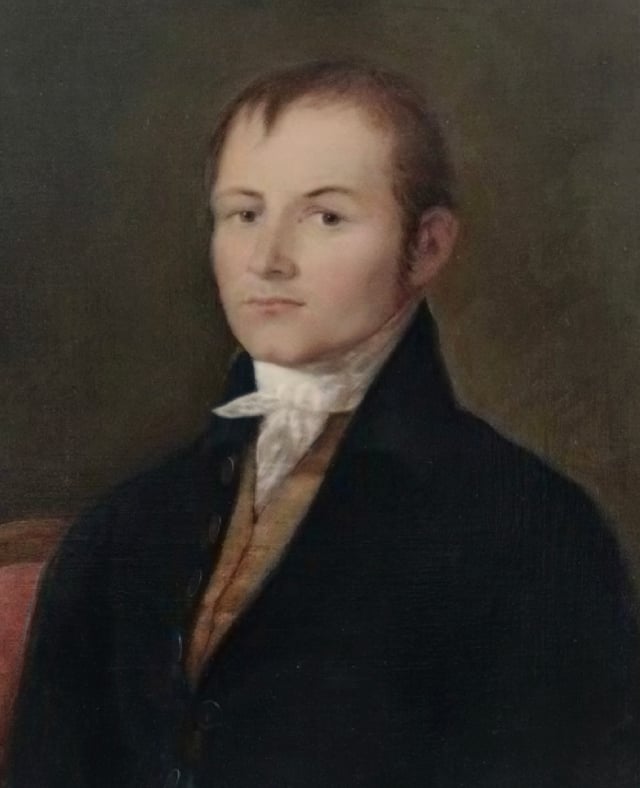
2nd Brown president, Jonathan Maxcy, 1792–1802 was the first alum to serve as president
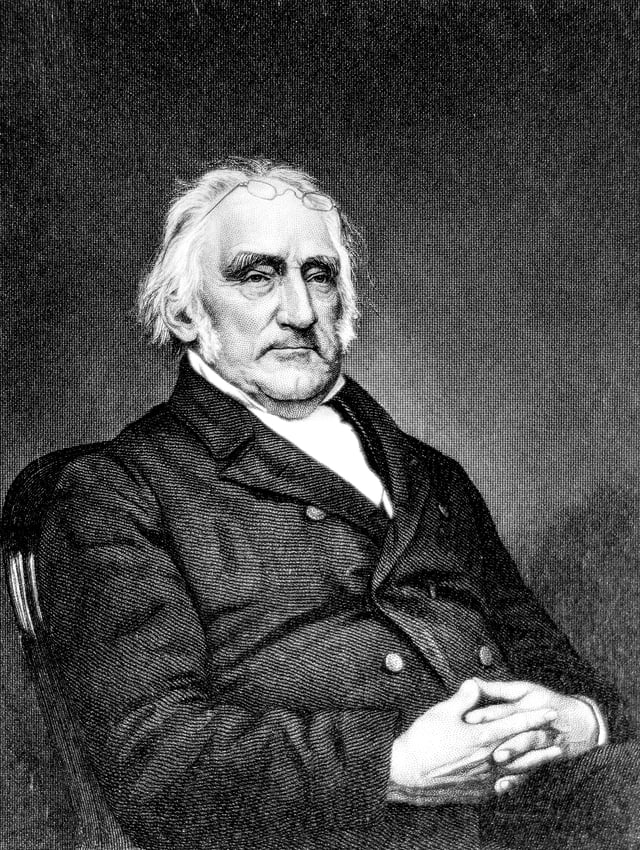
4th Brown president Francis Wayland, 1827-1855. His influential book Thoughts on the Present Collegiate System in the United States (1842) urged American universities to adopt a broader curriculum

18th Brown president Ruth J. Simmons, 2001–2012, was the first African-American to lead an Ivy League university
Brown's current president Christina Hull Paxson took office in 2012. She had previously been dean of the Woodrow Wilson School at Princeton University and a past-chair of Princeton's economics department.[55] In 2014 and 2015, Paxson presided over the year-long celebration of the 250th anniversary of Brown's founding. Her immediate predecessor as president was Ruth J. Simmons, the first African American president of an Ivy League institution. Simmons announced she would remain at Brown as a professor of Comparative Literature and Africana Studies.[56] However, Simmons is now the president of Prairie View A&M University, an HBCU in Texas.[57]
The College
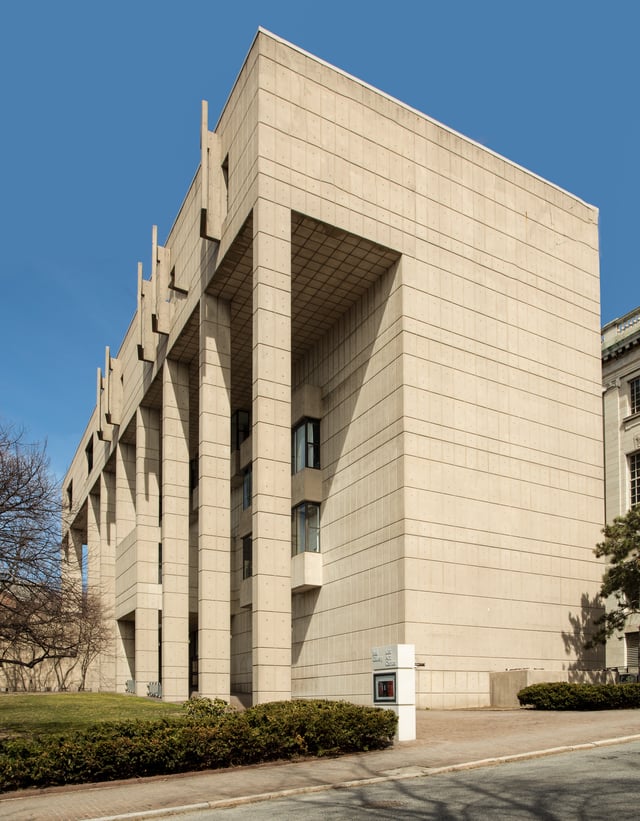
The List Art Center, built 1969-71, designed by Philip Johnson, houses the Department of Visual Art and the David Winton Bell Gallery, and is adjacent to the campus of the Rhode Island School of Design
Founded in 1764, the College is the oldest school of Brown University. About 6,400 undergraduate students are currently enrolled in the College, and 79 concentrations (majors) are offered. Completed concentrations of undergraduates by area are social sciences 42 percent, humanities 26 percent, life sciences 17 percent, and physical sciences 14 percent.[58] The concentrations with the greatest number of students are Biology, History, and International Relations. Brown is one of the few schools in the United States with an undergraduate concentration (major) in Egyptology. Undergraduates can also design an independent concentration if the existing programs do not align with their curricular focus.
35 percent of undergraduates pursue graduate or professional study immediately, 60 percent within 5 years, and 80 percent within 10 years.[59] For the Class of 1998, 75 percent of all graduates have since enrolled in a graduate or professional degree program.[60] The degrees acquired were doctoral 22 percent, master's 35 percent, medicine 28 percent, and law 14 percent.[60]
The highest fields of employment for graduates of the College are business 36 percent, education 19 percent, health/medical 6 percent, arts 6 percent, government 6 percent, and communications/media 5 percent.[60]
Brown/RISD Dual Degree Program
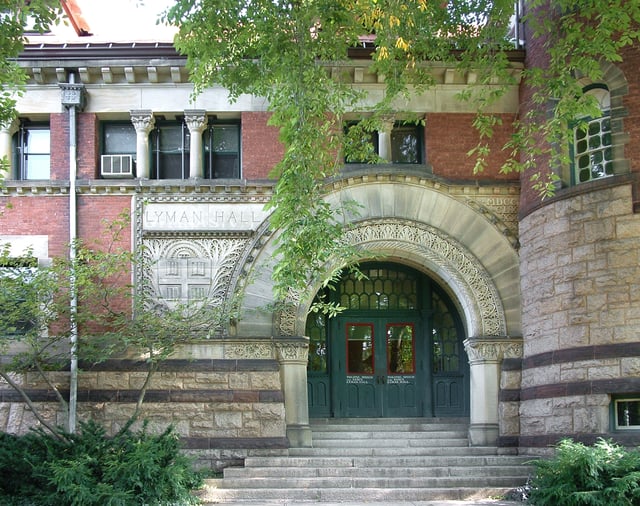
Lyman Hall, built 1890-92, designed by Stone, Carpenter and Willson in Richardsonian Romanesque style, houses the Department of Theatre Arts and Performance Studies
Brown's near neighbor on College Hill is the Rhode Island School of Design (RISD), America's top-ranked art college.[61] Brown and RISD students can cross-register at the two institutions, with Brown students permitted to take as many as four courses at RISD that count towards a Brown degree. The two institutions partner to provide various student-life services and the two student bodies compose a synergy in the College Hill cultural scene.
After several years of discussion between the two institutions and several students pursuing dual degrees unofficially, Brown and RISD formally established a five-year dual degree program in 2007, with the first class matriculating in the fall of 2008.[62] The Brown/RISD Dual Degree Program, among the most selective in the country, offered admission to 19 of the 707 applicants for the class entering in autumn 2018, an acceptance rate of 2.7 percent.[63] It combines the complementary strengths of the two institutions, integrating studio art and design at RISD with the entire spectrum of Brown's departmental offerings. Students are admitted to the Dual Degree Program for a course lasting five years and culminating in both the Bachelor of Arts (A.B.) or Bachelor of Science (Sc.B.) degree from Brown and the Bachelor of Fine Arts (B.F.A.) degree from RISD. Prospective students must apply to the two schools separately and be accepted by separate admissions committees. Their application must then be approved by a third Brown/RISD joint committee.
Admitted students spend the first year in residence at RISD completing its first-year Experimental and Foundation Studies curriculum, while taking up to three Brown classes. The second year is spent in residence at Brown, during which students take mainly Brown courses while starting on their RISD major requirements. In the third, fourth, and fifth years, students can elect to live at either school or off-campus, and course distribution is determined by the requirements of each student's unique combination of Brown concentration and RISD major. Program participants are noted for their creative and original approach to cross-disciplinary opportunities, combining, for example, industrial design with engineering, or anatomical illustration with human biology, or philosophy with sculpture, or architecture with urban studies. An annual "BRDD Exhibition" is a well-publicized and heavily attended event, drawing interest and attendees from the wider world of industry, design, the media, and the fine arts.
Theatre and playwriting
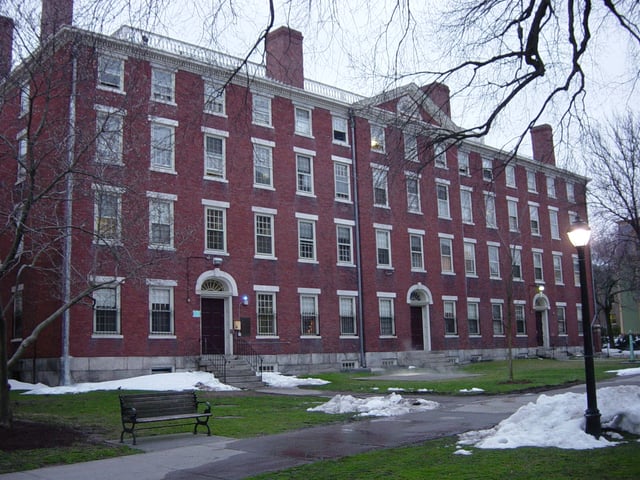
Hope College, built 1821-22 in late Federal style, was named for Hope Brown Ives, sister of Nicholas Brown, Junior, and was the first purpose-built residence hall at Brown
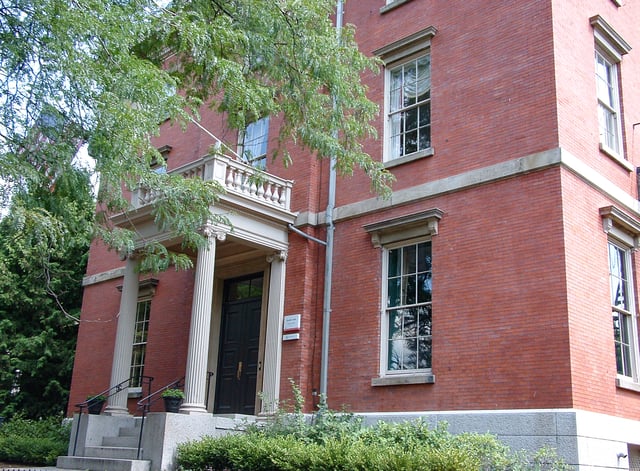
Membership in the Brown Faculty Club is open to all faculty, staff, alumni, and Brown parents, and confers reciprocal privileges at other clubs—in North America, England, Spain, and Israel—through the Association of College and University Clubs
Brown's theatre and playwriting programs are among the best-regarded in the country. Since 2003, eight different Brown graduates have either won (five times) or been nominated for (six times) the Pulitzer Prize—including winners Lynn Nottage '86 (twice—2009, 2017), Ayad Akhtar '93, Nilo Cruz '94, Quiara Alegría Hudes '04, Jackie Sibblies Drury MFA '04; and nominees Sarah Ruhl '97 (twice), Gina Gionfriddo '97 (twice), Stephen Karam '02, and Jordan Harrison '03. In American Theater magazine's 2009 ranking of the most-produced American plays, Brown graduates occupied four of the top five places—Peter Nachtrieb '97, Rachel Sheinkin '89, Sarah Ruhl '97, and Stephen Karam '02.[64][65]
The undergraduate concentration (major) encompasses programs in theatre history, performance theory, playwriting, dramaturgy, acting, directing, dance, speech, and technical production. Applications for doctoral and master's degree programs are made through the University Graduate School. Master's degrees in acting and directing are pursued in conjunction with the Rep MFA program, which partners with one of the country's great regional theatres, Trinity Repertory Company, home of the last longstanding resident acting company in the country.[66] Trinity Rep's present artistic director Curt Columbus succeeded Oskar Eustis in 2006, when Eustis was chosen to lead New York's Public Theater.
The many performance spaces available to Brown students include the Chace and Dowling theaters at Trinity Rep; the McCormack Family, Lee Strasberg, Rites and Reason, Ashamu Dance, Stuart, and Leeds theatres in University departments; the Upstairs Space and Downstairs Space belonging to the wholly student-run Production Workshop; and Alumnae Hall, used by Brown University Gilbert & Sullivan and by Brown Opera Productions. Production design courses utilize the John Street Studio of Eugene Lee, three-time Tony Award-winner.
Writing programs
Writing at Brown—fiction, non-fiction, poetry, playwriting, screenwriting, electronic writing, mixed media, and the undergraduate writing proficiency requirement—is catered for by various centers and degree programs, and a faculty that has long included nationally and internationally known authors. The undergraduate concentration (major) in literary arts offers courses in fiction, poetry, screenwriting, literary hypermedia, and translation. Graduate programs include the fiction and poetry MFA writing programs in the literary arts department, and the MFA playwriting program in the theatre arts and performance studies department. The non-fiction writing program is offered in the English department. Screenwriting and cinema narrativity courses are offered in the departments of literary arts and modern culture and media. The undergraduate writing proficiency requirement is supported by the Writing Center.
Author prizewinners
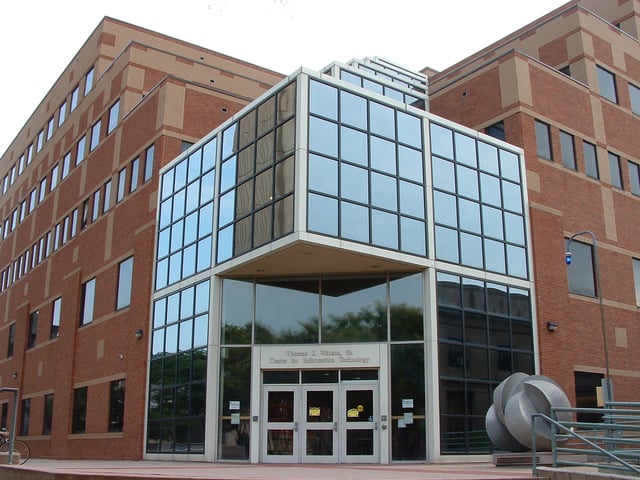
The Watson Center for Information Technology, built 1988, designed by Cambridge Seven Associates. It is named for Thomas J. Watson, Jr., Brown class of 1937, who led the global rise of IBM.
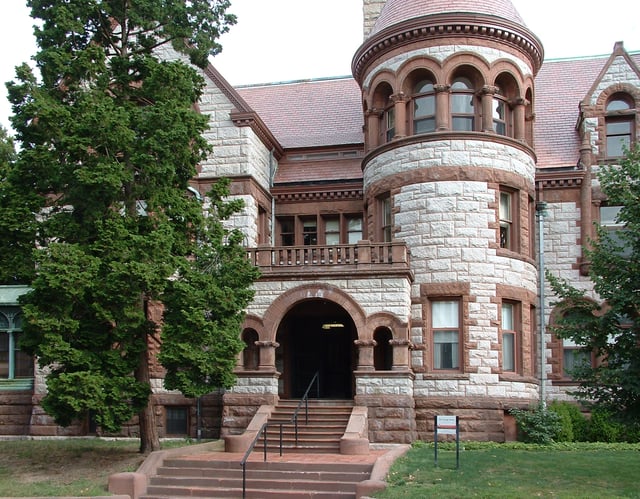
The division of applied mathematics in the former Henry Pearce House, built 1898, designed by Frank W. Angell and Frank H. Swift, acquired by Brown in 1952
Alumni authors take their degrees across the spectrum of degree concentrations, but a gauge of the strength of writing at Brown is the number of major national writing prizes won. To note only winners since the year 2000: Pulitzer Prize for Fiction-winners Jeffrey Eugenides '82 (2003), Marilynne Robinson '66 (2005), and Andrew Sean Greer '92 (2018); British Orange Prize-winners Marilynne Robinson '66 (2009) and Madeline Miller '00 (2012); Pulitzer Prize for Drama-winners Nilo Cruz '94 (2003), Lynn Nottage '86 (twice, 2009, 2017), Quiara Alegría Hudes '04 (2012), and Ayad Akhtar '93 (2013); Pulitzer Prize for Biography-winner David Kertzer '69 (2015); Pulitzer Prize for Journalism-winners James Risen '77 (twice, 2002, 2006), Mark Maremont '80 (twice, 2003, 2007), Gareth Cook '91 (2005), Tony Horwitz '80 (2005), Peter Kovacs '77 (2006), Stephanie Grace '86 (2006), Mary Swerczek '98 (2006), Jane B. Spencer '99 (2006), Usha Lee McFarling '89 (2007), James Bandler '89 (2007), Amy Goldstein '75 (2009), David Rohde '90 (twice, 1996, 2009), Kathryn Schulz '96 (2016), and Alissa J. Rubin '80 (2016); Pulitzer Prize for General Nonfiction-winner James Forman Jr. '88 (2018), as well as Pulitzer Prize for Poetry-winner Peter Balakian PhD '80.
Computer science
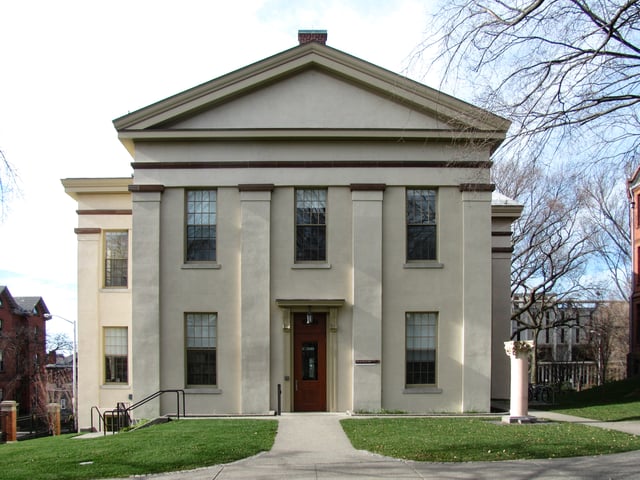
Rhode Island Hall on the College Green, built 1839-40, designed by James Bucklin in Greek Revival style to house the Natural History department, is now home to the Joukowsky Institute for Archaeology
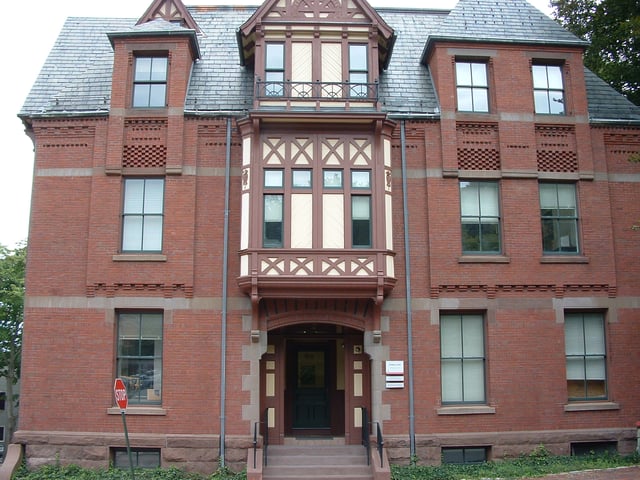
The Department of Egyptology and Assyriology in Wilbour Hall, the former Samuel Dorrance Mansion, built 1888. Wilbour Hall is named for Charles Edwin Wilbour, class of 1854, famed Egyptologist, whose collections and papers are held in the Wilbour Library in New York
Brown began offering computer science courses through the departments of Economics and Applied Mathematics in 1956 when it acquired an IBM machine. Brown added an IBM 650 in January 1958, the only one of its type between Hartford and Boston. In 1960, Brown opened its first dedicated computer building. The building, designed by Philip Johnson and opened on George Street, received an IBM 7070 computer the next year. Brown granted computer sciences full Departmental status in 1979. In 2009, IBM and Brown announced the installation of a supercomputer (by teraflops standards), the most powerful in the southeastern New England region.[67]
In the 1960s, Andries van Dam along with Ted Nelson, and Bob Wallace invented The Hypertext Editing Systems, HES and FRESS while at Brown. Nelson coined the word hypertext. Van Dam's students helped originate XML, XSLT, and related Web standards. Other Brown alumni have distinguished themselves in the computer sciences. They include a principal architect of the Classic Mac OS, a principal architect of the Intel 80386 microprocessor line, the Microsoft Windows 95 project chief, a CEO of Apple, the former head of the MIT Computer Science and Artificial Intelligence Laboratory, the inaugural chair of the Computing Community Consortium, and design chiefs at Pixar and Industrial Light & Magic, protegees of graphics guru Andries van Dam. The character "Andy" in the animated film Toy Story is taken to be an homage to Van Dam from his students employed at Pixar.[68] Van Dam denies this, but a copy of his book (Computer Graphics: Principles and Practice) appears on Andy's bookshelf in the film. Brown computer science graduate and Heroes actor Masi Oka '97, was an animator at Industrial Light & Magic.
The department today is home to The CAVE. This project is a virtual reality room used for everything from three-dimensional drawing classes to tours of the circulatory system for medical students. In 2000, students from Brown's Technology House converted the south face of the Sciences Library into a Tetris game, the first high-rise-building Tetris ever attempted. Code named La Bastille, the game used a personal computer running Linux, a radio-frequency video game controller, eleven circuit boards, a 12-story data network, and over 10,000 Christmas lights.[69][70]
In the early 2000s the department initiated a program entitled the Industry Partners Program that partners with outside companies, typically tech companies, to expose students to career opportunities.[71]
The Joukowsky Institute for Archaeology and the Ancient World

The Watson Institute for International and Public Affairs, built 2000-2002, designed by Rafael Viñoly
The Joukowsky Institute for Archaeology and the Ancient World pursues fieldwork and excavations, regional surveys, and academic study of the archaeology and art of the ancient Mediterranean, Egypt, and Western Asia from the Levant to the Caucasus. The Institute has a very active fieldwork profile, with faculty-led excavations and regional surveys presently in Petra, Jordan, in West-Central Turkey, at Abydos in Egypt, and in Sudan, Italy, Mexico, Guatemala, Montserrat in the West Indies, and Providence, Rhode Island.
The Institute's faculty includes cross-appointments from the departments of Egyptology, Assyriology, Classics, Anthropology, and History of Art and Architecture. Faculty research and publication areas include Greek and Roman art and architecture, landscape archaeology, urban and religious architecture of the Levant, Roman provincial studies, the Aegean Bronze Age, and the archaeology of the Caucasus. The Institute offers visiting teaching appointments and postdoctoral fellowships which have, in recent years, included Near Eastern Archaeology and Art, Classical Archaeology and Art, Islamic Archaeology and Art, and Archaeology and Media Studies.
Egyptology and Assyriology
Facing the Joukowsky Institute, across the Front Green, is the Department of Egyptology and Assyriology, formed in 2006 by the merger of Brown's renowned departments of Egyptology and History of Mathematics. It is one of only a handful of such departments in the United States. The curricular focus is on three principal areas: Egyptology (the study of the ancient languages, history, and culture of Egypt), Assyriology (the study of the ancient lands of present-day Iraq, Syria, and Turkey), and the history of the ancient exact sciences (astronomy, astrology, and mathematics). Many courses in the department are open to all Brown undergraduates without prerequisite, and include archaeology, languages, history, and Egyptian and Mesopotamian religions, literature, and science. Students concentrating (majoring) in the department choose a track of either Egyptology or Assyriology. Graduate level study comprises three tracks to the doctoral degree: Egyptology, Assyriology, or the History of the Exact Sciences in Antiquity.
The Watson Institute for International and Public Affairs
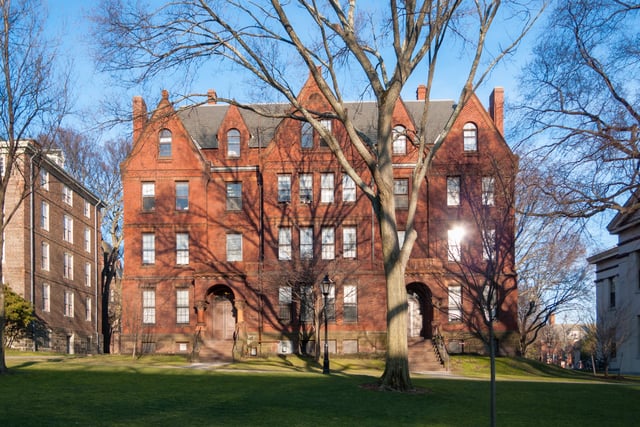
Slater Hall, built 1879, designed by Stone and Carpenter in Ruskinian Gothic style. When its foundation was dug at the south end of the College Green, neighbors objected that the Green "upon which so many are accustomed to gaze while taking daily walks" would be blocked from view, and Slater Hall was re-sited facing the Front Green
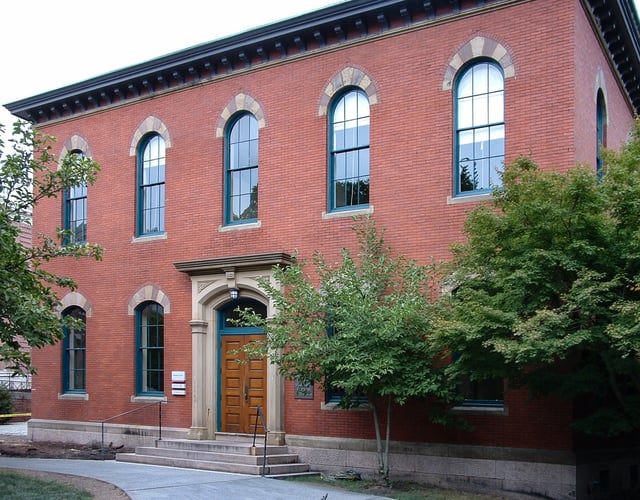
Rogers Hall on the College Green, built 1862, designed by Alpheus Morse in the Italian Gothic style as a chemistry laboratory, was renamed in 1989 the Salomon Center for Teaching
The Watson Institute for International and Public Affairs is a center for the study of global issues and public affairs and is one of the leading institutes of its type in the country. It occupies an architecturally distinctive building designed by Uruguayan architect Rafael Viñoly. The Institute was initially endowed by Thomas Watson, Jr., Brown class of 1937, former Ambassador to the Soviet Union, and longtime president of IBM. Institute faculty includes, or formerly included, Italian prime minister and European Commission president Romano Prodi,[72] Brazilian president Fernando Henrique Cardoso,[73] Chilean president Ricardo Lagos Escobar,[74] Mexican novelist and statesman Carlos Fuentes,[75] Brazilian statesman and United Nations commission head Paulo Sérgio Pinheiro,[76] Indian foreign minister and ambassador to the United States Nirupama Rao,[77] American diplomat and Dayton Peace Accords author Richard Holbrooke (Brown '62),[78] and Sergei Khrushchev,[79] editor of the papers of his father Nikita Khrushchev, leader of the Soviet Union.
The Institute's curricular interest is organized into the principal themes of development, security, and governance—with further focuses on globalization, economic uncertainty, security threats, environmental degradation, and poverty. Three Brown undergraduate concentrations (majors) are hosted by the Watson Institute—Development Studies, International Relations, and Public Policy. Graduate programs offered at the Watson Institute include the Graduate Program in Development (Ph.D.) and the Public Policy Program (M.P.A). The Institute also offers Post Doctoral, professional development and global outreach programming. In support of these programs, the Institute houses various centers, including the Brazil Initiative, Brown-India Initiative, China Initiative, Middle East Studies center, The Center for Latin American and Caribbean Studies (CLACS) and the Taubman Center for Public Policy. In recent years, the most internationally cited product of the Watson Institute has been its Costs of War Project, first released in 2011 and continuously updated. The Project comprises a team of economists, anthropologists, political scientists, legal experts, and physicians, and seeks to calculate the economic costs, human casualties, and impact on civil liberties of the wars in Iraq, Afghanistan, and Pakistan since 2001.
The School of Engineering
Established in 1847, Brown's engineering program is the oldest in the Ivy League and the third oldest civilian engineering program in the country, preceded only by Rensselaer Polytechnic Institute (1824) and Union College (1845). In 1916, the departments of electrical, mechanical, and civil engineering were merged into a Division of Engineering, and in 2010 the division was elevated to a School of Engineering.
Engineering at Brown is especially interdisciplinary. The School is organized without the traditional departments or boundaries found at most schools, and follows a model of connectivity between disciplines—including biology, medicine, physics, chemistry, computer science, the humanities and the social sciences. The School practices an innovative clustering of faculties in which engineers team with non-engineers to bring a convergence of ideas.
IE Brown Executive MBA Dual Degree Program
Since 2009, Brown has developed an Executive MBA program in conjunction with one of the leading Business Schools in Europe; IE Business School in Madrid. This relationship has since strengthened resulting in both institutions offering a dual degree program.[80] In this partnership, Brown provides its traditional coursework while IE provides most of the business-related subjects making a differentiated alternative program to other Ivy League's EMBAs.[81] The cohort typically consists of 25-30 EMBA candidates from some 20 countries.[82] Classes are held in Providence, Madrid, Cape Town and Online.
The Pembroke Center
The Pembroke Center for Teaching and Research on Women was established at Brown in 1981 by Joan Wallach Scott as a research center on gender. It was named for Pembroke College, the former women's coordinate college at Brown, and is affiliated with Brown's Sarah Doyle Women's Center. It supports the undergraduate concentration in Gender and Sexuality Studies, post-doctoral research fellowships, the annual Pembroke Seminar, and other academic programs. The Center also manages various collections, archives, and resources, including the Elizabeth Weed Feminist Theory Papers and the Christine Dunlap Farnham Archive.
The Graduate School
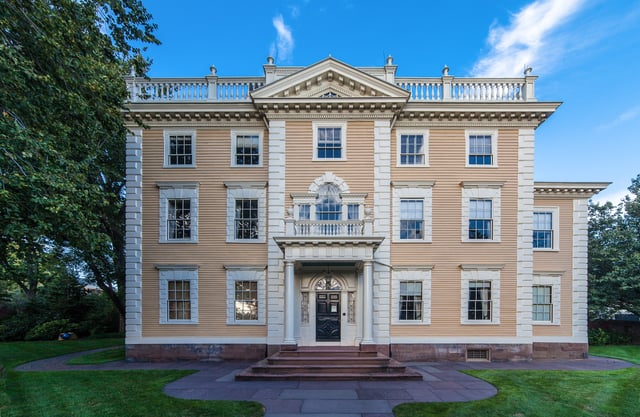
Constructed in 1792, the Nightingale–Brown House, the longtime family seat of the Brown family, is listed on the National Register of Historic Places, and is home to Brown's John Nicholas Brown Center for Public Humanities and Cultural Heritage.

The Ship Street Farmer's Market in front of the Medical Education Building on the campus of Brown's Alpert Medical School in the Jewelry District
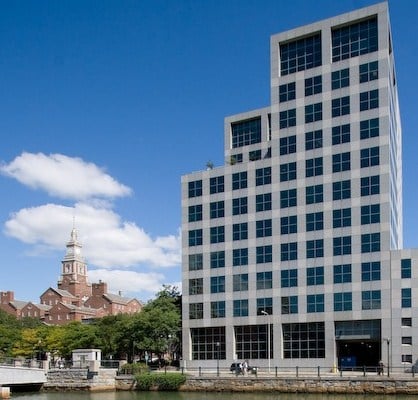
Brown's School of Public Health on the Riverwalk in Providence occupies a building designed by Edward Larrabee Barnes
Established in 1887, the Graduate School has around 2,000 students studying over 50 disciplines. 20 different master's degrees are offered as well as Ph.D. degrees in over 40 subjects ranging from applied mathematics to public policy. Overall, admission to the Graduate School is most competitive with an acceptance rate of about 10 percent.
Alpert Medical School
The University's medical program started in 1811, but the school was suspended by President Wayland in 1827 after the program's faculty declined to live on campus (a new requirement under Wayland). In 1975, the first M.D. degrees from the new Program in Medicine were awarded to a graduating class of 58 students. In 1991, the school was officially renamed the Brown University School of Medicine, then renamed once more to Brown Medical School in October 2000.[83] In January 2007, Warren Alpert donated $100 million to Brown Medical School, in recognition of which its name was changed to the Warren Alpert Medical School of Brown University.
The medical school is known especially for its eight-year Program in Liberal Medical Education (PLME), inaugurated in 1984. One of the most selective and renowned programs of its type in the country, it offered admission to 90 of the 2,290 applicants for the class entering in autumn 2015, an acceptance rate of 3.9 percent.[63] Since 1976, the Early Identification Program (EIP) has encouraged Rhode Island residents to pursue careers in medicine by recruiting sophomores from Providence College, Rhode Island College, the University of Rhode Island, and Tougaloo College. In 2004, the school once again began to accept applications from premedical students at other colleges and universities via AMCAS like most other medical schools. The medical school also offers combined degree programs leading to the M.D./Ph.D., M.D./M.P.H. and M.D./M.P.P. degrees.
The Marine Biological Laboratory
The Marine Biological Laboratory (MBL) is an independent research institution established in 1882 at Woods Hole, Massachusetts. The laboratory is linked to 54 current or past Nobel Laureates who have been research or teaching faculty. Since 2005, the MBL and Brown have collaborated in a Ph.D. program in biological and environmental sciences that combines faculty at both institutions, including the faculties of the Ecosystems Center, the Bay Paul Center, the Program in Cellular Dynamics, and the Marine Resources Center.
Online Programs

The building in which the School of Professional Studies resides.
The Brown University School of Professional Studies currently offers blended learning Executive master's degrees in Healthcare Leadership, Cyber Security, and Science and Technology Leadership.[86] The master's degrees are designed to help students who have a job and life outside of academia to progress in their respective fields. The students meet in Providence, RI every 6–7 weeks for a week seminar each trimester.
The University has also invested in MOOC development starting in 2013, when two courses, Archeology's Dirty Little Secrets and The Fiction of Relationship, both of which received thousands of students.[87] However, after a year of courses, the University broke its contract with Coursera and revamped its online persona and MOOC development department. By 2017, the University released new courses on edx, two of which were The Ethics of Memory and Artful Medicine: Art's Power to Enrich Patient Care. In January 2018, Brown published its first "game-ified" course called Fantastic Places, Unhuman Humans: Exploring Humanity Through Literature, which featured out of platform games to help learners understand materials, as well as a story-line that immerses users into a fictional world to help characters along their journey.[88]
Admissions and financial aid
| 2019[89] | 2018[90] | 2017[91] | 2016[92][93] | 2015[94] | 2014[95] | 2013[96] | 2012[97] | |
|---|---|---|---|---|---|---|---|---|
| Applicants | 38,674 | 35,437 | 32,723 | 32,390 | 30,396 | 30,431 | 28,919 | 28,742 |
| Admits | 2, 551 | 2,718 | 2,779 | 3,014 | 2,875 | 2,661 | 2,654 | 2,759 |
| Admit rate | 6.6% | 7.7% | 8.5% | 9.3% | 9.5% | 8.7% | 9.2% | 9.6% |
| Enrolled | N/A | 1,657 | 1,639 | 1,681 | 1,615 | 1,561 | 1,543 | 1,539 |
| SAT range | N/A | 1420-1550 | 1405-1570[1] | 2060-2350 | 2060-2340 | 2000-2330 | 2000-2310 | 1990-2310 |
| ACT range | N/A | 32-35 | 31-35 | 31-34 | 31-34 | 30-34 | 29-34 | 29-34 |
For the undergraduate class of 2022 (enrolling in Fall 2018), Brown received 35,438 applications, the largest applicant pool in the University's history. 2,566 were accepted for an acceptance rate of 7.2%, the lowest in university history.[90] Additionally, for the academic year 2015-16 there were 1,834 transfer applicants, of whom 8.9% were accepted, with an SAT range of 2180-2330, ACT range of 31-34, and average college GPA of 3.85.[98] In 2017, the Graduate School accepted 11% of 9,215 applicants.[99] In 2014, U.S. News ranked Brown's Warren Alpert Medical School the 5th most selective in the country, with an acceptance rate of 2.9 percent.[84]
Brown admission policy is stipulated need-blind for all domestic first-year applicants. In 2017, Brown announced that loans would be eliminated from all undergraduate financial aid awards starting in 2018-2019, as part of a new $30 million campaign called the Brown Promise.[100] In 2016-17, the university awarded need-based scholarships worth $120.5 million. The average need-based award for the class of 2020 was $47,940.[101]
Sustainability
Brown has committed to "minimize its energy use, reduce negative environmental impacts and promote environmental stewardship."[102] The Energy and Environmental Advisory Committee has developed a set of ambitious goals for the university to reduce its carbon emissions and eventually achieve carbon neutrality. The "Brown is Green" website collects information about Brown's progress toward greenhouse gas emissions reductions and related campus initiatives, such as student groups, courses, and research.[103] Brown's grade of A-minus was the top one issued in the 2009 report of the Sustainable Endowments Institute (no A-grade was issued).[104] Brown has a number of active environmental leadership groups on campus.[105] These groups have begun a number of campus-wide environmental initiatives—including promoting the reduction of supply and demand of bottled water and investigating a composting program.
According to the A. W. Kuchler U.S. potential natural vegetation types, Brown University would have a dominant vegetation type of Appalachian Oak (104) with a dominant vegetation form of Eastern Hardwood Forest (25).[106]
Athletics
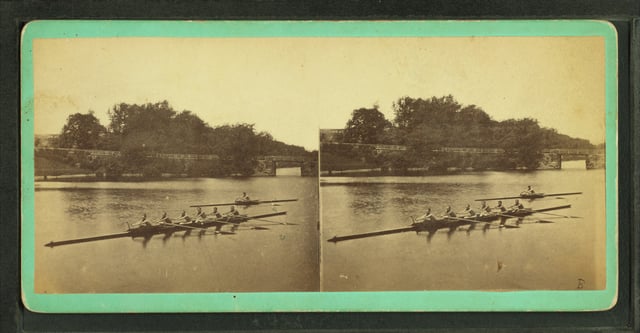
A stereoscopic image of the Brown freshman crew in competition at Lake Quinsigamond, Mass., on July 22, 1870. Brown rowing, among the pioneer programs in the country, dates from June 1857. Its first three-school regatta was held with Harvard and Yale at Lake Quinsigamond on July 27, 1859[107]
Brown is a member of the Ivy League athletic conference, which is categorized as a Division I (top level) conference of the National Collegiate Athletic Association (NCAA). The Brown Bears are the third largest university sports program in the United States, sponsoring 38 varsity intercollegiate teams (Harvard sponsors 42 and Princeton 39). Brown's athletic program is one of the U.S. News & World Report top 20—the "College Sports Honor Roll"—based on breadth of program and athletes' graduation rates. Brown's newest varsity team is women's rugby, promoted from club-sport status in 2014.
Brown women's rowing has won 7 national titles between 1999 and 2011.[112] Brown men's rowing perennially finishes in the top 5 in the nation, most recently winning silver, bronze, and silver in the national championship races of 2012, 2013, and 2014. The men's and women's crews have also won championship trophies at the Henley Royal Regatta and the Henley Women's Regatta. Brown's men's soccer is consistently ranked in the top 20, and has won 18 Ivy League titles overall; recent soccer graduates play professionally in Major League Soccer and overseas. Brown football, under its most successful coach historically, Phil Estes, won Ivy League championships in 1999, 2005, and 2008. (Brown football's reemergence is credited to its 1976 Ivy League championship team, "The Magnificent Andersons," so named for its coach, John Anderson.) High-profile alumni of the football program include Houston Texans head coach Bill O'Brien; former Penn State football coach Joe Paterno, Heisman Trophy namesake John W. Heisman, and Pollard Award namesake Fritz Pollard. The Men's Lacrosse team also has a long and storied history. Brown women's gymnastics won the Ivy League tournament in 2013 and 2014. Brown varsity equestrian has won the Ivy League championship several times.[113] Brown also supports competitive intercollegiate club sports, including sailing and ultimate frisbee. The men's ultimate team, Brownian Motion, has won three national championships, in 2000, 2005 and 2019.[114] The Brown women's sailing team has won 5 national championships, most recently in 2019[115] while the coed sailing team won 2 national championships in 1942 and 1948.[116] Both teams are consistency ranked in the top 10 in the nation.[117]
Student life
Campus safety
In 2014, Brown University tied with the University of Connecticut for the highest number of reported rapes in the nation, with its "total of reports of rape" on their main campus standing at 43.[121]
Spring weekend
The weekend includes an annual spring concert festival that has featured numerous famous artists.
Residential and Greek societies

Ladd Observatory, built 1890–1891, is on the National Register of Historic Places.
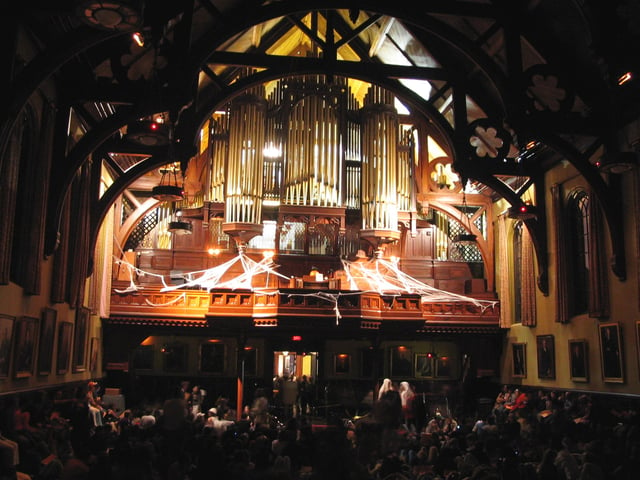
The largest surviving Hutchings-Votey organ in the world is in Sayles Hall.[123] It has 3,355 pipes and weighs 25 tons. It is pictured here for Brown's traditional Halloween midnight concert.
About 12 percent of Brown students are in fraternities and sororities. There are 11 residential Greek houses: six fraternities (Beta Rho Pi, Delta Phi, Delta Tau, Phi Kappa Psi, Sigma Chi, and Theta Delta Chi; four sororities (Alpha Chi Omega, Kappa Alpha Theta, Delta Gamma, and Kappa Delta), one co-ed house (Zeta Delta Xi), and one co-ed literary society (Alpha Delta Phi). Phi Sigma Kappa fraternity was present on campus from 1906 to 1939, but was unable to reactivate after World War II due to wartime losses.[122] All recognized Greek-letter organizations are located on campus in Wriston Quadrangle in university-owned housing. They are overseen by the Greek Council.
An alternative to Greek-letter organizations are the program houses organized by themes. As with Greek houses, the residents of program houses select their new members, usually at the start of the spring semester. Examples of program houses are St. Anthony Hall (located in King House), Buxton International House, the Machado French/Hispanic/Latinx House, Technology House, Harambee (African culture) House, Social Action House and Interfaith House.
Currently, there are three student cooperative houses at Brown. Two of them, Watermyn and Finlandia on Waterman Street, are owned by the Brown Association for Cooperative Housing (BACH), a non-profit corporation owned by its members. The third co-op, West House, is located in a Brown-owned house on Brown Street. The three organizations run a vegetarian co-op for the larger community.
All students not in program housing enter a lottery for general housing. Students form groups and are assigned time slots during which they can pick among the remaining housing options.
Societies and clubs

The sesquicentennial poster
The earliest societies at Brown were devoted to oration and debate. The Pronouncing Society is mentioned in the diary of Solomon Drowne, class of 1773, who was voted its president in 1771. It seems to have disappeared during the American Revolutionary War. We next hear of the Misokosmian Society, founded in 1794 and renamed the Philermenian Society in 1798. This was effectively a secret society with membership limited to 45. It met fortnightly to hear speeches and debate and thrived until the Civil War; in 1821 its library held 1594 volumes. In 1799, a chapter of the Philandrian Society, also secret, was established at the College. In 1806, the United Brothers was formed as an egalitarian alternative to the Philermenian Society. "These two great rivals," says the University historian, "divided the student body between them for many years, surviving into the days of President Sears. A tincture of political controversy sharpened their rivalry, the older society inclining to the aristocratic Federals, the younger to the Republicans, the democrats of that day. ... The students continuing to increase in number, they outran the constitutional limits of both societies, and a third, the Franklin Society, was established in 1824; it never had the vitality of the other two, however, and died after ten years."[124] Other nineteenth century clubs and societies, too numerous to treat here, are described in Bronson's history of the University.[125]
The Cammarian Club—founded in 1893 and taking its name from the Latin for lobster, its members' favorite dinner food—was at first a semi-secret society which "tapped" 15 seniors each year. In 1915, self-perpetuating membership gave way to popular election by the student body, and thenceforward the Club served as the de facto undergraduate student government. In 1971, unaccountably, it voted the name Cammarian Club out of existence, thereby amputating its tradition and longevity. The successor and present-day organization is the generically-named Undergraduate Council of Students.
Societas Domi Pacificae, known colloquially as "Pacifica House," is a present-day, self-described secret society, which nonetheless publishes a website and an email address. It claims a continuous line of descent from the Franklin Society of 1824, citing a supposed intermediary "Franklin Society" traceable in the nineteenth century. But the intermediary turns out to be, on closer inspection, the well-known Providence Franklin Society, a civic organization unconnected to Brown whose origins and activity are well-documented. It was founded in 1821 by merchants William Grinnell and Joseph Balch, Jr., and chartered by the General Assembly in January 1823.[126] The "Pacifica House" account of this (conflated) Franklin Society cites published mentions of it in 1859, 1876, and 1883. But the first of these (Rhees 1859, see footnote infra) is merely a sketch of the 1824 Brown organization; the second (Stockwell 1876) is a reference-book article on the Providence Franklin Society itself; and the third is the Providence Franklin Society's own publication, which the "Pacifica House" reference mis-ascribes to the "Franklin Society," dropping the word "Providence."[127]
Student organizations
There are over 300 registered student organizations on campus with diverse interests. The Student Activities Fair, during the orientation program, provides first-year students the opportunity to become acquainted with the wide range of organizations. A sample of organizations includes:
The College Hill Independent
Brown Badmaash Dance Company
The Brown Daily Herald
Brown Debating Union
The Brown Derbies
Brown International Organization
Brown Journal of World Affairs
The Brown Jug
The Brown Noser
Brown Opera Productions
Brown Political Review
The Brown Spectator
BSR
Brown University Band
Brown University Orchestra
The Chattertocks of Brown University
Chinese Students and Scholars Association
The College Hill Independent
Critical Review
Ivy Film Festival
Jabberwocks
Production Workshop
Starla and Sons
Students for Sensible Drug Policy
WBRU
Resource centers
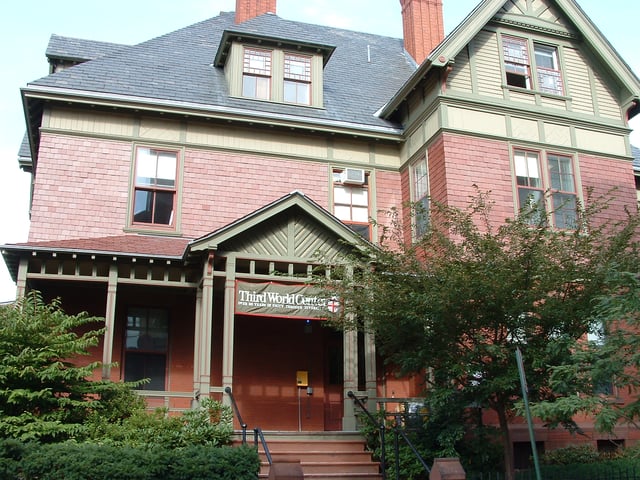
The Brown Center for Students of Color
Brown University has several resource centers on campus. The centers often act as sources of support as well as safe spaces for students to explore certain aspects of their identity. Additionally, the centers often provide physical spaces for students to study and have meetings. Although most centers are identity-focused, some provide academic support as well.
The Brown Center for Students of Color (BCSC) is a space that provides support for students of color. Established in 1972 at the demand of student protests, the BCSC encourages students to engage in critical dialogue, develop leadership skills, and promote social justice.[128] The center houses various programs for students to share their knowledge and engage in discussion. Programs include the Third World Transition Program, the Minority Peer Counselor Program, the Heritage Series, and other student-led initiatives. Additionally, the BCSC hopes to foster community among the students it serves by providing spaces for students to meet and study.
The Sarah Doyle Women's Center aims to provide a space for members of the Brown community to examine and explore issues surrounding gender.[129] The center was named after one of the first women to attend Brown University, Sarah Doyle. The center emphasizes intersectionality in its conversations on gender, encouraging people to see gender as present and relevant in various aspects of life. The center hosts programs and workshops in order to facilitate dialogue and provide resources for students, faculty, and staff.[130]
Other centers include the LGBTQ+ Center, the First-Generation College and Low-Income Student (FLi) Center, and the Curricular Resource Center.
Rankings
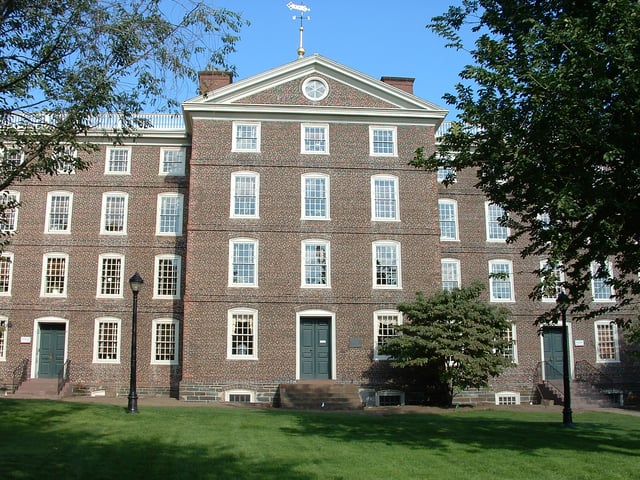
University Hall, built 1770–1771, designed by a committee that included Joseph Brown, is on the National Register of Historic Places
The Forbes magazine annual ranking of "America's Top Colleges 2019" — which ranked 650 research universities, liberal arts colleges and service academies — ranked Brown 7th overall and 7th among universities.[141]
Washington Monthly ranked Brown 28th among 395 national universities in the U.S. based on its contribution to the public good, as measured by social mobility, research, and promoting public service.[143]
In 2014, Forbes magazine ranked Brown 7th on its list of "America's Most Entrepreneurial Universities".[146] The Forbes analysis looked at the ratio of "alumni and students who have identified themselves as founders and business owners on LinkedIn" and the total number of alumni and students.
LinkedIn particularized the Forbes rankings, placing Brown third (between MIT and Princeton) among "Best Undergraduate Universities for Software Developers at Startups." LinkedIn's methodology involved a career-path examination of "millions of alumni profiles" in its membership database.[147]
In 2017, U.S. News ranked Brown's Warren Alpert Medical School the 7th most selective in the country, tied with the UC Davis School of Medicine and the UCLA School of Medicine, with an acceptance rate of 2.7 percent.[148]
Notable people
Alumni in politics include U.S. Secretary of State John Hay (1852), U.S. Secretary of State and Attorney General Richard Olney (1856), Chief Justice of the United States and U.S. Secretary of State Charles Evans Hughes (1881), Senator Maggie Hassan '80 of New Hampshire, Governor Jack Markell '82 of Delaware, Rhode Island Representative David Cicilline '83, Minnesota Representative Dean Phillips '91, 2020 Presidential candidate and entrepreneur Andrew Yang '96, and DNC Chair Tom Perez '83.
Prominent alumni in business and finance include philanthropist John D. Rockefeller Jr. (1897), Chair of the Federal Reserve Janet Yellen '67, World Bank President Jim Yong Kim '82, Bank of America CEO Brian Moynihan '81, CNN founder and America's Cup yachtsman Ted Turner '60, IBM chairman and CEO Thomas Watson, Jr. '37, Apple Inc. CEO John Sculley '61, Uber CEO Dara Khosrowshahi '91,[149][150] and magazine editor John F. Kennedy, Jr. '83.
Important figures in the history of education include the father of American public school education Horace Mann (1819), civil libertarian and Amherst College president Alexander Meiklejohn, first president of the University of South Carolina Jonathan Maxcy (1787), Bates College founder Oren B. Cheney (1836), University of Michigan president (1871–1909) James Burrill Angell (1849), University of California president (1899–1919) Benjamin Ide Wheeler (1875), and Morehouse College's first African-American president John Hope (1894).
Alumni in the computer sciences and industry include architect of Intel 386, 486, and Pentium microprocessors John H. Crawford '75, and inventor of the first silicon transistor Gordon Kidd Teal '31.
Alumni in the arts and media include actress Jessica Capshaw '98, actor Daveed Diggs '04,[151] actress Emma Watson '14, NPR program host Ira Glass '82, singer-composer Mary Chapin Carpenter '81, humorist and Marx Brothers screenwriter S.J. Perelman '25, novelists Nathanael West '24, Jeffrey Eugenides '83, Edwidge Danticat (MFA '93), and Marilynne Robinson '66; actress Jo Beth Williams '70, composer and synthesizer pioneer Wendy Carlos '62, journalist James Risen '77, political pundit Mara Liasson, MSNBC host and The Nation editor-at-large Chris Hayes '01, New York Times, publisher A. G. Sulzberger '04, and actress Julie Bowen '91.
Other notable alumni include "Lafayette of the Greek Revolution" and its historian Samuel Gridley Howe (1821) Governor of Wyoming Territory and Governor of Nebraska John Milton Thayer (1841), Governor of Rhode Island Augustus Bourn (1855), NASA head during first seven Apollo missions Thomas O. Paine '42, diplomat Richard Holbrooke '62, sportscaster Chris Berman '77, Houston Texans head coach Bill O'Brien '92, 2018 Miss America Cara Mund '16, Penn State football coach Joe Paterno '50, Heisman Trophy namesake John W. Heisman '91, Olympic and world champion triathlete Joanna Zeiger, royals and nobles such as Prince Rahim Aga Khan, Prince Faisal bin Al Hussein of the Hashemite Kingdom of Jordan, Princess Leila Pahlavi of Iran '92, Prince Nikolaos of Greece and Denmark, Prince Nikita Romanov, Princess Theodora of Greece and Denmark, Prince Jaime of Bourbon-Parma, Duke of San Jaime and Count of Bardi, Prince Ra'ad bin Zeid, Lady Gabriella Windsor, Prince Alexander von Fürstenberg, Countess Cosima von Bülow Pavoncelli, and her half-brother Prince Alexander-Georg von Auersperg, David Shrier, American futurist and author, and Olympic gold ('98), silver ('02), and bronze ('06) medal-winning hockey player Katie King-Crowley '97.
Nobel Laureates Craig Mello '82 and Jerry White '87, Cooley–Tukey FFT algorithm co-originator John Wilder Tukey '36, biologist Stanley Falkow (PhD '59), and psychologist Aaron Beck '50.
Notable past or current faculty have included Nobel Laureates Michael Kosterlitz, Lars Onsager, George Stigler, Vernon L. Smith, George Snell and Leon Cooper; Fields Medal winning mathematician David Mumford, Pulitzer Prize–winning historian Gordon S. Wood, Sakurai Prize winning physicist Gerald Guralnik, computer scientist Andries van Dam, engineer Daniel C. Drucker, sociologist Lester Frank Ward, former Prime Minister of Italy and former EU chief Romano Prodi, former President of Brazil Fernando Cardoso, former President of Chile Ricardo Lagos, writers Carlos Fuentes, Chinua Achebe, and Robert Coover, philosopher Martha Nussbaum, linguist Hans Kurath, political scientist James Morone, biologist Kenneth R. Miller, and Senior Fellow Sergei Khrushchev.
In popular culture
Brown's reputation as an institution with a free-spirited, iconoclastic student body is portrayed in fiction and popular culture.[153] Family Guy character Brian Griffin is a Brown alumnus.[154] The O.C.'s main character Seth Cohen is denied acceptance to Brown while his girlfriend Summer Roberts is accepted.[155] In The West Wing, Amy Gardner is a Brown alumna. In Gossip Girl, New York socialite Serena vies with her friends for a spot at Brown.
See also
List of Brown University statues
Brown University Alma Mater
Josiah S. Carberry

